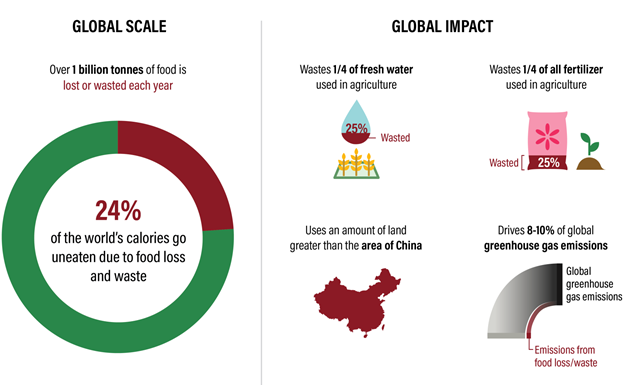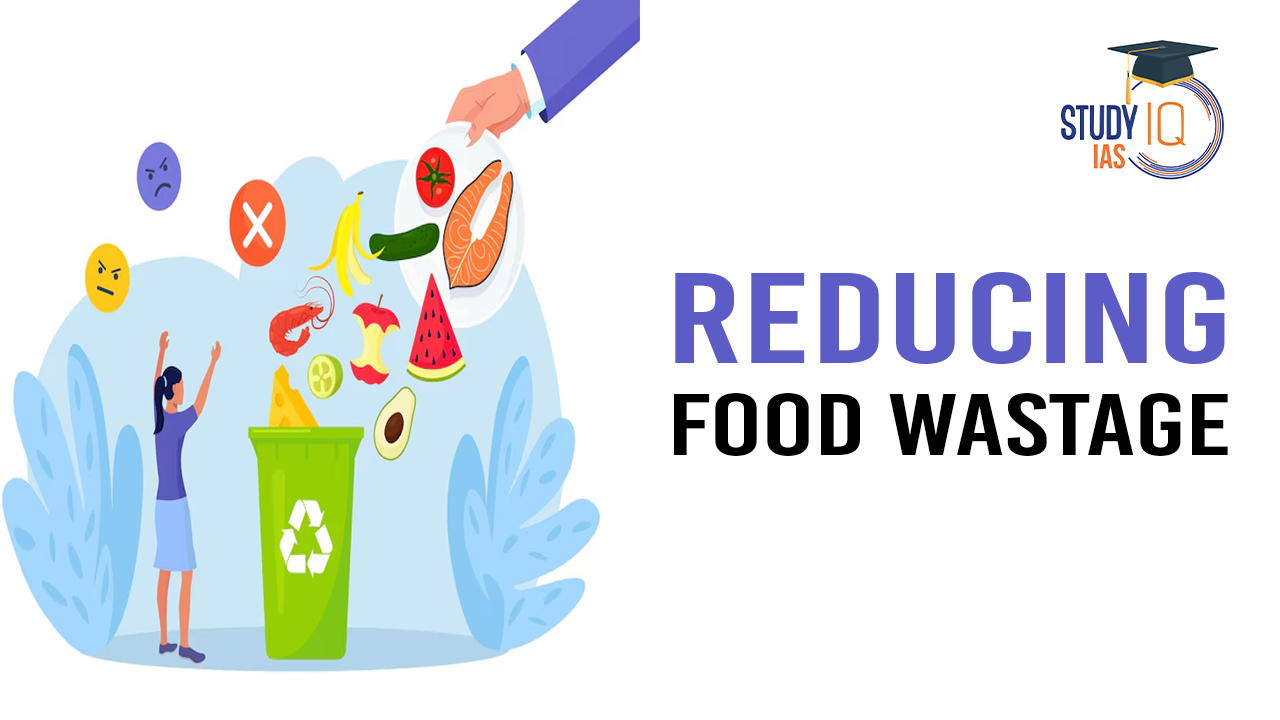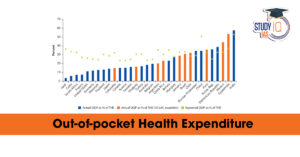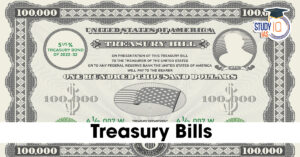Table of Contents
Context: The UNEP Food Waste Index Report 2024 highlights that 1.05 billion tonnes of food were wasted globally in 2022 (nearly 20% of all food available to consumers).
The International Day of Awareness of Food Loss and Waste (FLW) is observed annually on September 29, co-convened by the Food and Agriculture Organization (FAO) and the United Nations Environment Programme (UNEP). This day aims to raise awareness about the critical issues surrounding food loss and waste, emphasising their implications for food security and environmental sustainability.
Recent Trends in Food Wastage
- India ranks among the top contributors to food waste, with 78 million tonnes of food discarded annually — second only to China.
- While India’s per capita food waste is 55 kg annually, lower than some developed nations like the US (73 kg), the sheer population size makes the total wastage volume significant.
- Approximately 61% of global food waste occurs at the household level due to over-purchasing, poor storage, and improper meal planning.
Check here: International Day of Zero Waste
What is meant by Food Wastage?
- Food wastage is a broader term that includes both food loss and food waste — covering the entire food supply chain from production to consumer disposal.
- Example: Spoiled grains due to poor storage (food loss) and uneaten cooked meals (food waste).
| Food Loss and Food Waste |
|
Issues and Challenges
- Supply Chain Inefficiencies: Poor storage facilities, lack of cold chains, and inadequate transport infrastructure lead to high food loss at the production and distribution stages.
- Consumer Behaviour: Over-purchasing, lack of meal planning, and excessive food preparation at household levels result in avoidable wastage.
- Policy and Infrastructure Gaps: Limited investment in cold storage, poor market linkages, and lack of effective redistribution networks exacerbate the problem.
Implications of Food Wastage
- Environmental Impact: Food wastage increases greenhouse gas emissions (8%–10% of annual global emissions), primarily from methane released in landfills.
- Wasted food also leads to overuse of resources like water, land, and energy during production and distribution.
- Economic Loss: Globally, food wastage costs around $1 trillion annually in terms of lost production, transportation, and storage costs.
- Businesses and households face higher expenses due to inefficient food management.
- Food Insecurity: Despite surplus production, millions face hunger due to inefficient food distribution and wastage.
- In India, over 20 crore people face hunger, while 78 million tonnes of food are discarded annually.
- Social Injustice: Wastage reflects unequal access to food — surplus food in some areas contrasts with hunger and malnutrition in others.
- It widens the gap between food availability and accessibility.
- Pressure on Natural Resources: Food production requires significant amounts of water, land, and energy; wastage puts additional strain on these limited resources.
- Increased demand for food production leads to deforestation and biodiversity loss.
- Challenge to Sustainable Development: Food wastage hinders progress toward SDG 2 (Zero Hunger) and SDG 12.3 (Reducing food waste at retail and consumer levels).
- Higher food wastage increases the environmental footprint, slowing down global sustainability efforts.
India’s Initiatives to Tackle Food Wastage
- Save Food, Share Food: Launched by the Food Safety and Standards Authority of India (FSSAI) to encourage donation of surplus food to the needy through food banks and NGOs.
- Indian Food Sharing Alliance (IFSA): A network of food recovery agencies under FSSAI that facilitates food redistribution from businesses and households to reduce waste.
- Operation Greens: Launched in 2018 to stabilize the supply of perishable crops (like tomatoes, onions, and potatoes) by improving storage, transportation, and market linkages.
- Mega Food Parks Scheme: Establishes food processing infrastructure with cold storage, packaging, and logistics to reduce food loss during production and distribution.
- Food Processing Incentives: The Production-Linked Incentive (PLI) Scheme for the food sector encourages investment in food processing and better storage infrastructure.
- Mid-Day Meal Scheme: Reduces food wastage in schools by ensuring planned meal preparation and effective distribution to students, minimizing excess food disposal.
| International Models Addressing Food Waste |
|
What Needs to Be Done
- Enhance Storage and Distribution: Improve cold chain infrastructure and modernise transportation to reduce food loss at the production stage.
- Consumer Education: Promote awareness about meal planning, proper food storage, and creative reuse of leftovers to reduce household waste.
- Redistribution Networks: Scale up initiatives like “Save Food Share Food” to connect surplus food with those in need.
- Policy Reforms: Introduce incentives and subsidies for businesses and farmers to adopt sustainable practices and improve food storage.
- Promote Composting and Recycling: Encourage household and community-level composting to reduce landfill waste and generate organic manure.
- Support Sustainable Consumption: Encourage plant-based diets, reduce overproduction, and optimise food supply chains to minimise resource use and emissions.
Main Drivers of Food Loss and Waste Throughout the Supply Chain

Impact of Food Loss And Waste
- Hunger and Malnutrition: Food wastage can also negatively impact food security and food availability, and contribute to increasing the cost of food.
- This excludes many people from accessing quality food owing to poor socio-economic conditions.
- Example: In the Global Hunger Index, 2023 India ranks 111th out of 125 counties with 14% of Indians undernourished.

| Other Facts |
|
- Greenhouse Gas Emission: The disposal of food loss and waste in landfills, leads to greenhouse gas emissions, contributing to climate change.
- Example: It accounts for approximately 8%-10% of global greenhouse gas emissions.
- Economic Impact: According to The United Nations Environment Programme estimates that India wastes 74 million tonnes of food each year, representing a loss of 92,000 crore rupees, and securing India second rank (after China).
- Wastage of Resources: When food is lost or wasted, all the resources that were used to produce this food – including water, land, energy, labour and capital – go to waste.
India’s Initiatives to Reduce Food Loss and Waste
- Indian Food Sharing Alliance (IFSA): It has been formed by the Food Safety and Standards Authority of India (FSSAI) to help solve India’s food waste and hunger crisis by working with various partner organisations, Food Recovery Agencies and NGO’s
- Taskforce Against Food Loss and Waste: A proposal is underway to establish a national Taskforce aimed at reducing food loss and waste (FLW) in India, aligning with the UN’s Sustainable Development Goal 12.3, which seeks to halve global food waste by 2030
- Operation Green: It aims to promote Farmer Producers Organizations (FPO), Agri-logistics, processing facilities and professional management of agri-produce.
- SAMPADA (Scheme for Agro-Marine Processing and Development of Agro-Processing Clusters) Yojana: This scheme involves developing an integrated cold chain and value addition infrastructure.
- Mega Food Parks: To enhance processing capabilities, improve cold chain infrastructure, and create a more efficient supply chain, thus reducing post-harvest losses
- National Food Security Act, 2013: It places an obligation on the government to deliver quality food at affordable prices to the poor.
What are the Solutions?
- Promoting Mechanization in Agriculture: Use of combine harvesters to reduce post-harvest losses, especially for crops like paddy.
- Mechanization significantly cuts losses compared to manual harvesting.
- Encouraging Farmer Producer Organizations (FPOs) and Custom Hiring Centres (CHCs) to facilitate group leasing of machinery, making it more accessible to small and marginal farmers.
- Improving Drying and Storage Infrastructure: Adoption of solar dryers and dehydrators to replace traditional sun drying, which is prone to contamination and uneven drying.
- These green technologies are cost-effective and extend the shelf life of perishables.
- Expansion of proper storage facilities to reduce grain loss.
- The government’s plan to add 70 million metric tons (MMT) of storage capacity over five years can help minimise post-harvest losses.
- Revisiting Packaging Methods: Revising the Jute Packaging Material Act (JPMA, 1987) to promote the use of airtight bags instead of jute bags, which are prone to rodent attacks and pilferage in tropical climates.
- Airtight bags can significantly reduce storage and transit losses.
- Enhancing Farming Practices: Food producers, including farmers, ranchers, and fishers, can minimise losses by adopting better farming practices, such as harvesting crops at the right maturity and using suitable equipment.
- Example: Utilising weather apps like Mausam can help them optimise harvesting schedules and engage with wholesale retailers to manage order changes effectively.
- FIFO Method: The “First In, First Out” method encourages using older products before newer ones to ensure nothing expires unused.
- Promoting Food Donation Drives: Organizing food donation drives in communities can be a powerful way to channel excess food to those who require it most.
- Example: Zero food wastage initiative by Dawoodi Bohras in Pune.
- Policy Support: Providing policy incentives to ensure small and marginal farmers can access advanced machinery, storage solutions, and infrastructure improvements.


 SEBI’s SWAGAT-FI Framework for Low-Ris...
SEBI’s SWAGAT-FI Framework for Low-Ris...
 Out-of-Pocket Health Expenditure, Reason...
Out-of-Pocket Health Expenditure, Reason...
 Treasury Bills (T-bills): RBI Cuts Holdi...
Treasury Bills (T-bills): RBI Cuts Holdi...

























